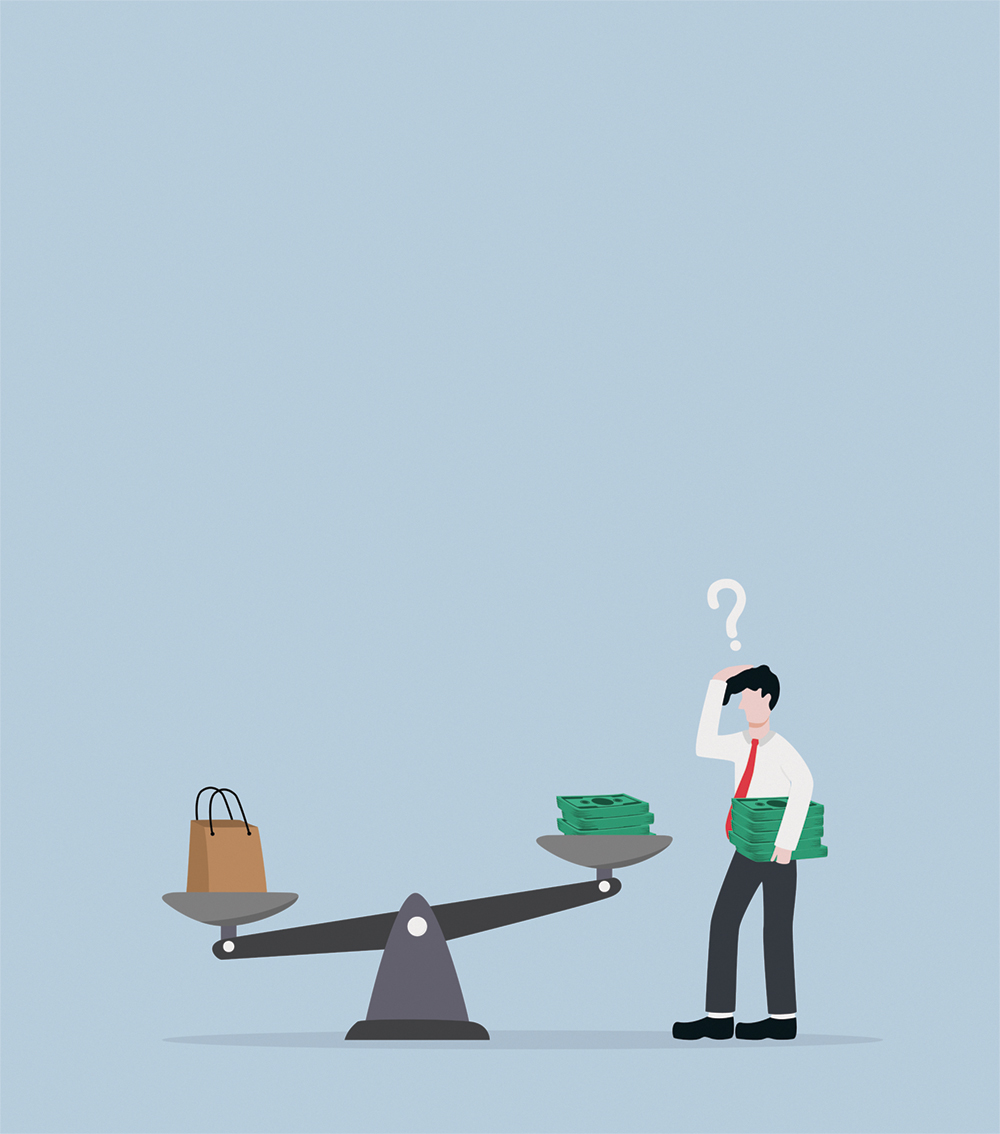
- Adapting is the only way out in absence of a focused economic masterplan to navigate the immediate challenges
Rampant inflation and the rising cost of living are a reality that is plaguing the life of the common Nepali. Nepal Rastra Bank estimated that the Consumer Price Inflation remained at 4.95% on a year-on-year (y-o-y) basis compared to 7.38 % a year ago based on the five months’ data in mid-December for fiscal year 2023/24. However, this national average is not the same for all regions of Nepal. Inflation rates for the Kathmandu valley stand at 5.42%, Terai at 4.26%, Hills at 5.42% and in the mountains at 7.46% in the review month.
The most important thing to note however is that rising cost of living disproportionately affects those who are poorer.
Food Security
According to the Annual Household Survey conducted by the Central Bureau of Statistics in 2015/16, “Food is the major expenditure item in both urban and rural areas in 2015/16 having a proportion of 59.8% in rural and 44.9% in urban area.” The Global Food Security Index 2022, created by the Economist Impact, ranks Nepal 13 out of 113 countries regarding food availability but places us at 85th in affordability. Speaking to individuals shopping at a vegetable store leads to a singular opinion that the kitchen is getting more expensive.
For many rural Nepalis, the most immediate sting comes from rising food prices. A study by Nepal Rastra Bank entitled ‘The Impact of Food Inflation on Poverty in Nepal’ by Min Bahadur Shrestha, PhD and Shashi Kant Chaudhary estimates that “A food price hike of 10% will push one million new consumers into overall poverty, while 6.7 million existing poor populations would experience even harder lives.”
In Nepal’s mountain regions, which account for over 6% of the country’s population, high altitude and limited arable land leads to dependence on imported food transported over long distances at an increasing cost. This, coupled with limited income opportunities, affects mountain communities making them highly vulnerable to food price shocks. Recently, several restaurants in the village of Gorakshep inside the Sagarmatha National Park witnessed an uptick in menu rate. A comparison can be made through the basic boiled egg, priced at around Rs 300 per egg, a significant contrast to Kathmandu, where a single boiled egg does not cost more than Rs 30. While all foodstuffs may not be subject to such a massive increase, any increment makes things unbearably expensive. Remote locations often lack access to diverse and affordable food options. This dependence on local markets makes them vulnerable to price fluctuations, particularly for essential staples.
Despite shrinking yields, there are rising costs. For many rural Terai communities, subsistence farming has been a cornerstone of food security. According to a study conducted by the International Fund for Agricultural Development, approximately 84% of Nepalis live in rural areas and depend on subsistence agriculture for their livelihoods and to provide food for themselves. However, rising fertilisers, seeds and fuel costs are making it increasingly arduous to maintain yields. It is compounded by extreme weather patterns, driven by climate change, further jeopardising harvests. While the fertile plains offer more agricultural potential, the densely populated Terai heavily relies on purchased food. Rising prices can quickly push large swaths of the population into food insecurity, particularly those in poverty. A sudden spike in the price of rice or wheat can have devastating consequences for families already struggling to make ends meet.
A mixed picture emerges when looking at the hilly region. Urban areas, with better access to markets and diverse food options, are somewhat shielded from the immediate impact. However, rural hill communities, often reliant on subsistence farming and facing limited income sources, experience significant hardship due to rising food costs.
Urban residents may have access to wide range of food options but are not immune to rising costs. Food deserts, areas lacking access to supermarkets and fresh produce stores, are a growing concern in many cities.
Transport and Lack of Infrastructure
Fueling frustration, primarily due to rising fuel prices, is another vital concern in rural areas. Access to essential goods and services are limited in rural areas, and inflation can exacerbate this. Transportation costs to reach markets or healthcare facilities can rise, and shortages of essential goods might occur due to disruptions in supply chains.
The isolation amplifies costs. The Kalimati Fruits and Vegetables Market Development Board, the largest wholesale market for agricultural products in Nepal, receives goods from throughout Nepal. Binay Shrestha, Information Officer, said, “Inadequate roads and limited public transportation in rural areas translate to higher logistical costs for transporting goods to the market. These additional expenses eat into profits, making it harder for rural producers to compete and access fair prices. Especially since they have to compete with imports from India and China, whose produce is preferred by the public due to proper post-harvest measures. On top of that, market access bottlenecks plus lack of proper storage facilities and cold chains in rural areas lead to post-harvest losses, further reducing the already limited surplus available for trade. It limits income and hinders diversification into higher-value crops. It is most common in the hilly and mountainous regions where road infrastructure is more gruelling to create and maintain.”
Transportation woes are not exclusive to rural areas. Urbanites face rising public transport fares and fuel costs, adding to the daily financial strain. For many urban dwellers, transportation costs are a significant burden. With price increases to the public transport systems, many have struggled with budgeting for their daily commute. Urban infrastructure often struggles to keep pace with population density. Overcrowded roads and ports lead to delays and inefficiencies, raising transportation costs and impacting the timely delivery of goods. There are also some sellers who upcharge many urban citizens.
“We have also implemented a system where the public can access the daily updated prices of goods through our website. While this does stop the sellers from artificially inflating prices at the Kalimati market itself, we do not have the capacity to monitor what goes on outside the market at local stores. Better provisions for monitoring and reporting scalpers who inflate the price artificially are necessary. There are no entities like us in other parts of Nepal. Maybe there needs to be some more to monitor in integral parts of the country,” says Shrestha
Land and Rent
According to the Annual Household Survey conducted by the Central Bureau of Statistics in 2015/16, “For rent, rural households are spending 9% of their total expenditure which is more than double spending for rent by urban households at 18.7%.” Rising housing costs are a primary concern for urban dwellers, particularly renters. As apartments and rooms experience inflation-driven price hikes, many struggle to keep up with the pace. The survey further states, “There are currently 13.1% of households that reside in rented houses, which is 24.6% in urban and 2.5% in rural areas.”
Rising costs of living are impacting rent and land prices in both urban and rural areas, but the nature of the squeeze is far from uniform. The demand always outpaces the supply. Cities are magnets for opportunity, drawing in job seekers and investors alike. This influx in population has created a housing crunch, with demand for apartments and rentals far exceeding supply. Landlords, capitalising on this scarcity, push rents skyward, with rent in Kathmandu expected to rise by 10% every two years.
As wages struggle to keep pace with inflation, housing costs become increasingly burdensome for urban dwellers. Many are forced to downgrade living spaces, share accommodations, or even relocate to more affordable suburbs. The perception of urban real estate as a safe haven during economic uncertainty fuelled a buying frenzy. This influx of investment capital further inflates land prices, making homeownership an increasingly distant dream for many. In conversation with the public, this problem was especially experienced by the youth, especially students who had migrated to Kathmandu for their education. “Our living situations end up being a struggle, leaving us no time to study properly,” lamented a student from Charikot.
Rising urban costs are driving some residents to seek refuge in the countryside. This influx of demand puts pressure on rural land prices, particularly in areas with scenic beauty or recreational potential. As land values rise, some rural landowners opt to sell their holdings for development, leading to the conversion of agricultural land into housing estates or commercial ventures. It can disrupt traditional livelihoods and threaten food security. While some rural areas experience a land price boom, others remain stagnant or even see decline. It can exacerbate existing inequalities, leaving communities struggling to attract investment and retain residents.
Rise in the cost of living is one primary reason for majority of Nepali citizens leaving the country. The opportunity to combat rising cost of living through remittance is a story that most Nepali families are familiar with. Same reasons can also be attributed to the phenomena of internal migration. A study entitled “Outmigration and Land-Use Change: A Case Study from the Middle Hills of Nepal” by Bhawana KC notes that the primary reason for rural to urban migration of farmers ends up being the lack of access to markets, low value for agricultural products, labour shortages and expensive labourers, high production costs and unprofitable farming in rural areas.
Sabita Bhattarai, Communication and Documentation Officer of Maiti Nepal, says, “The majority of people who are trafficked are lured with the allure of escaping the poverty of their current situation which they cannot cope with due to the rising cost of living. A lot of the mobility is also intra-national where a lot of minors end up leaving rural areas for the mirage of urban freedom. The rising cost of living with no upward social mobility pushes them to migrate to urban areas where the lack of accessible necessities forces them to get into prostitution and other difficult positions.”
Wage or Income
Many rural Nepalis depend heavily on agriculture or seasonal wage labour which are always low or fixed wages that barely match inflation. The Ministry of Labour, Employment and Social Security has fixed the monthly minimum wage at Rs 17,300. It accounts for a base pay of Rs 10,820 and dearness allowance of Rs 6,480 accounting for inflation. However, this does not occur at a suitable pace with the wage being reviewed only every two years as per existing provisions. The review also does not guarantee an increase.
The 2021/22 census reports the total number of farm population is 19,477,955. Thus, 67% of the population works in an industry mostly localised in the rural Terai. Inflation always hits rural incomes harder, especially those relying on agriculture or fixed wages. Inflationary pressures on agricultural inputs and declining crop prices leave them squeezed from both ends. Crop prices may not keep pace with rising costs of inputs like fertilisers or fuel, and wage increases in farm jobs might be slow or non-existent. Many are forced to cut back on food or send their children out to work instead of going to school.
Urban residents may have more diversified job opportunities that offers more inflation-linked adjustments. However, it may also not be true with salary hikes not matching inflation, especially for low-wage earners. Additionally, the urban cost of living, including rent and commuting expenses, can inflate faster than incomes.
While food and housing remain primary concerns, the impact of inflation also extends to leisure and entertainment. With shrinking discretionary spending, urban residents, once able to enjoy occasional outings or meals outdoors, now find themselves cutting back on these seemingly non-essential expenses. Speaking to many urban residents, even meeting up for a coffee feels like a luxury they can’t afford.
Conclusion
Shraddha Gautam, Advisory Board Member of Nepal Economic Forum, notes that our country relies heavily on imports, especially since it is landlocked with a low industrial base. “The infrastructure bottleneck and high transport cost already cause the cost of doing business to skyrocket. On top of that, the import tariffs and duties levied on various raw materials necessary for key industries, makes the cost of doing business that much more expensive, in the end raising the cost of the products for the consumers.
The government needs to take a long term perspective by focusing on building infrastructure and key strategic industries. And this must be done with the intension of creating jobs and raising living standards for the people. Creating an enabling environment for businesses and supporting the entrepreneurial ecosystem will go a long way in achieving this.”
Taking into account global trends like the effects of the pandemic on global supply chains, price fluctuations that wars can cause on major commodities, any decrease in remittance and the ripple effects of changes in the monetary policies of major economies are all compounded by the country’s immense dependency on imported goods.
The government never ends up securing enough control. With its currency pegged to the Indian Rupee, Nepal’s influence over its own rates of inflation ends up being minimal, changes in Indian policies having drastic consequences here.
The latest World Economic Situation and Prospects report for 2024 conducted by the United Nations Department of Economic Affairs posits that inflation is geared to decrease in the upcoming year, finally ending the upsurge due to the Covid 19 pandemic. However, numerous international events including the Ukraine-Russia war, threaten to disrupt the expected stability. In light of it all, Nepal Rastra Bank, whose primary duty is inflation control and maintaining monetary stability, does not seem to have enough control to do much else but adapt.



-1765706286.jpg)
-1765699753.jpg)

